By Vitaly Portniikov
KYIV
A canal dug and brought into service in Soviet times to provide water for irrigation in Crimea – but now blocked and disused – could this be the next flashpoint in the conflict pitting Russia and Ukraine?
The Northern Crimea Canal was one of those Soviet engineering feats intended to ease the recurring drought and change the face of agriculture and industry – undertaken when Crimea, once an independent Turkic khanate taken over by the Russian empire in 1783, had been transferred from Soviet Russia to “fraternal” Soviet Ukraine.
The project was actually intended to underscore Crimea’s links with mainland Ukraine and the waters of the Dnipro basin, intrinsic features of the Communist state.
But Crimea remained a bone of contention throughout 23 years of an uneasy relations between Moscow and Kyiv after the collapse of Soviet rule and the issue – exploding into Russia’s annexation of the region in 2014 after mass protests forced Ukraine’s Russia-friendly president to flee the country.
After the largely bloodless takeover of Crimea – consolidated by a referendum denounced in Kyiv and the West as rigged – Ukraine stopped all work and maintenance on the canal. Russia – and Crimea’s new pro-Russian leaders — initially said that move was of no consequence to Crimea’s new status. Water could be had by some other means.
But Russia has radically changed its tune on water and on the status and fate of the canal.
Russian officials and commentators now decry in apocalyptic terms Ukraine’s construction of a make-shift dam 90 km into its course – near the border with Crimea.
Mass murder, genocide
“This is not just an attempt to deny us water and deal us a multi-billion economic blow,” the pro-Russian Crimean Prime minister, Vladimir Konstantinov, said earlier this year.
He pledged to launch “civil proceedings” against Ukrainian authorities.
“This is an attempt to destroy us as a people, an attempt to commit mass murder and genocide.”
Russian statements have also been beaming a different message – while loudly proclaiming in 2014 that Crimea had no natural or historic connection to Ukraine, the notion now is that by interrupting the flow of the canal’s water, it is Ukraine who is dissociating itself from its longstanding links to Crimea.
Ukraine retorts that Crimea has sufficient water for its and reopening the canal would simply used to supply Russia’s Black Sea Fleet in the Crimean port of Sevastopol – in Kyiv’s eyes, aiding an occupying power.
And the annexation, in fact, resulted in something that Crimea had avoided for centuries – it turned the peninsula into a de facto island – with communication made possible by the construction of a gleaming new bridge to the Russian mainland.
Reopening the canal, from an engineering standpoint, might not prove easy. And the issue has become something of a litmus test in Kyiv to gauge the “Ukraine-ness” of any politician – current Prime Minister Denys Shmyhal spoke in favour of resuming the canal’s flow until a torrent of nationalist outrage forced him to rethink his position.
With Russia’s recent military buildup in Crimea and in areas adjacent to regions of Donbass occupied by Kremlin proxies – and reports that some 75,000 troops remain near the border despite the Kremlin’s assurances of a pullback – the question remains: Would Russia launch a war against Ukraine over the supply of water?
Any suggestion of an incursion in to Ukraine from Crimea would negate Kremlin leader Vladimir Putin’s strategy of recent years.
Putin portrayed the annexation of Crimea in 2014 as a move undertaken by the region’s “self-defence force” endorsing the will of the people to be once more administered from Moscow. The creation of separatist “people’s republics” in eastern Ukraine was depicted as a “popular uprising” against what Moscow unfailingly describes as an extreme right-wing coup that ousted Viktor Yanukovich, their man in Kyiv.
But as Crimea is now by Russian law a fully integrated part of the Russian Federation – and not a self-proclaimed body — any move to seize territory in southern Ukraine from a base in the peninsula would be engineered by the Russian military and could hardly be described as an act of “volunteers” or a “popular uprising”. And that would have legal consequences for Moscow.
New sources of water, or military action?
Would it be economically advantageous for Putin to seek out alternative sources of water or to engage in some sort of military action?
With Ukraine on edge for months, maintaining that tension around the shutdown of the canal or other calls for Russia to secure a “land corridor” in southern Ukraine could well be to Putin’s advantage by placing additional pressure on the Kyiv government.
And Moscow might even make use of post-Soviet changes in demographics in Crimea – while part of Soviet Ukraine, northern Crimea was agricultural land populated by ethnic Ukrainians and Crimean Tatars who have returned to the peninsula decades after being expelled as wartime collaborators by Stalin. But farming in that region has declined and many residents – and newcomers from Russia itself – have tended to settle in Crimea’s larger towns, belying the Ukrainian view of a multi-ethnic Crimea.
This does not by any means suggest that Moscow will cease exploiting the water issue in sowing discord and trying to keep Ukraine off balance.
But in essence, if Putin decides on any sort of military action from Crimea, the disrupted operation of the North Crimea Canal will serve more as a pretext, rather than a real basis for that action.

